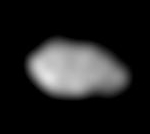Metis (moon)
| Metis | |
|---|---|

|
|
| Jupiter's moon Metis recorded by Galileo between November 1996 and June 1997 . | |
| Provisional or systematic name | S / 1979 J 3 |
| Central body | Jupiter |
| Properties of the orbit | |
| Major semi-axis | 127,969 km |
| Periapsis | 127,800 km |
| Apoapsis | 128,100 km |
| eccentricity | 0.0012 |
| Orbit inclination | 0.019 ° |
| Orbital time | 0.295 d |
| Mean orbital velocity | 31.55 km / s |
| Physical Properties | |
| Albedo | 0.061 |
| Apparent brightness | 17.50 likes |
| Medium diameter | 43 km |
| Dimensions | 119,893,474,647,775,000 kg |
| Medium density | 2.8 g / cm 3 |
| Sidereal rotation | 0.295 days |
| Axis inclination | 0 ° |
| Acceleration of gravity on the surface | 0.0180 m / s 2 |
| Escape speed | 28/ 0 m / s |
| discovery | |
| Explorer | |
| Date of discovery | March 4th 1979 |
| Remarks | Simply bound rotation, Jupiter's innermost moon |
Metis (also Jupiter XVI) is the innermost known moon of the planet Jupiter .
discovery
The moon was discovered in 1979 by the astronomer Stephen Synnott ( Voyager Science Team ) on images taken by the Voyager 1 space probe and was initially given the provisional designation S / 1979 J 3 . In 1983 it was officially named after the titan Metis from Greek mythology , the first wife of Zeus .
Orbit data
Metis moves within Jupiter's ring system and is believed to be a source for the ring particles. Metis orbits Jupiter within the geostationary orbital radius and is exposed to the huge tidal forces of the giant planet. The moon is small enough not to be torn apart by the forces, but its orbit will decrease in the future, so that it - like the next outer moon Adrastea - will eventually fall into Jupiter.
Metis is within the Roche limit for liquid moons; That is, it is only stable through the cohesion of its material. The escape speed is only valid for a movement at right angles to the gas planet .
Structure and physical data
Meti's density of 2.8 g / cm³ suggests, on the one hand, that it is composed in equal parts of water ice and silicate rock. On the other hand, the very dark surface speaks against the presence of ice.
Web links
- IAUC 3507: Satellites of Jupiter Aug 26, 1980 (discovery)
- IAUC 3872: Satellites of Jupiter and Saturn September 30, 1983 (numbering and naming)
- Jupiter: Moons: Metis. NASA - Solar System Exploration(English).
- Jovian Satellite Fact Sheet. NASA - NSSDC(English).
-
Metis. In: The
Nine8 Planets. - solarsystem.nasa.gov
- secure.planetary.org
| before | Jupiter moons | after that |
| Adrastea | Metis |
Callirrhoe |
